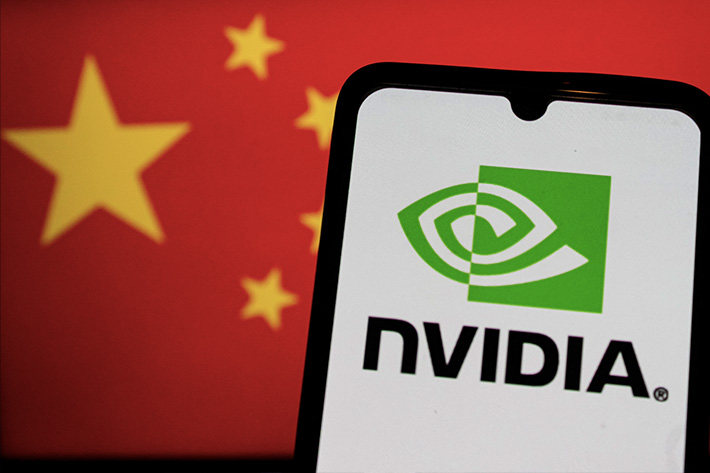Shares of Chinese semiconductor firms were on a high on Wednesday as investors put stock in a Beijing announcement claiming the development of two chipmaking machines, including one ‘capable of making 8nm chips’.
Early this month, China’s Ministry of Industry and Information Technology (MIIT) published a new list of “major technological equipment” which included two deep ultraviolet (DUV) lithography machines — equipment critical to chipmaking.
The machines “have achieved significant technological breakthroughs, own intellectual property rights but have yet to perform on the market”, MIIT said in the release and called on domestic chip firms to use the machines.
Also on AF: Japan Nears China Chip Curbs Deal With ‘Very Bad Cop’ US
The guidance, reported last week, fuelled big jumps in shares of beaten-down Chinese chip firms on Wednesday, as mainland markets reopened after two trading holidays.
Shanghai Zhangjiang Hi-Tech Park Development and Shanghai Highly Group both hit their daily limit of 10% gains by market close. Sanhe Tongfei Refrigeration, which has a wider trading band, reached its 20% daily limit.
Shenyang Blue Silver Industry Automation Equipment ended the day up 10.7%.
But while investors celebrated the apparent progress in an industry increasingly cut off from advanced tech — thanks to US-led export curbs — experts remain doubtful that the ‘breakthrough’ is worth all that.
For one, the newly announced lithography machines are still 15 years behind most advanced lithography machines used globally, according to Leslie Wu, chief executive of consulting firm RHCC.
Tech ‘confusion’
The more advanced of the two lithography machines mentioned in the list, for which MIIT did not specify a supplier, has a resolution of 65 nanometers or better.
Resolution determines how small the features on a semiconductor chip can be made. Smaller resolutions allow for more advanced, powerful chips.
For comparison, ASML’s most advanced lithography machines currently achieve resolutions of 8 nanometers and less.
Furthermore, according to a report by Taiwan state-backed Central News Agency, the machines may not even be able to produce 28nm chips — let alone 8nm ones.
The report said the public cheer was likely the result of a lack of knowledge about what the specifications released by MIIT actually mean.
China eager to register ‘win’ on US sanctions
The biggest significance of the MIIT announcement is that it comes at a time when ASML — the world’s biggest maker of lithography machines — faces new restrictions in selling DUV machines to China.
So far this year, China has bought one of every two machines ASML has sold — all of which are DUV equipment. But ASML will now need licences from the Dutch government to sell two older types of DUV machines to China.
The DUV machines are ASML’s second-tier product line — the company has not sold any of its most advanced EUV (extreme ultraviolet) machines to China due to earlier restrictions.
Starting this month, ASML will also need licences from the Dutch government to provide spare parts and software updates for DUV machines it has previously sold to Chinese customers.
The new restrictions could temporarily cripple Chinese fabs as lithography machines need regular servicing and maintenance, without which they can become unusable after a point.
Given the scenario, a ‘breakthrough’ would be China’s way to signal progress in developing domestic chipmaking technology and moving past the US-led tech strangle.
View this post on Instagram
Dismal returns
In 2020, China’s biggest lithography equipment maker Shanghai Micro Electronics Equipment (SMEE) promised to deliver the country’s first homegrown 28nm-capable machine by 2022.
It was only in December last year, however, that the firm finally announced it had successfully developed the machine — only for that announcement to be swiftly deleted.
Meanwhile, Huawei — China’s current torch-bearer in the chip development department — has successfully developed a homegrown 7nm chip using stockpiled ASML machines. The company is also reportedly working with state-backed SMIC to produce 5nm chips.
But experts say Huawei’s yield remains low — and costs high — as using older machines for advanced chips can produce a greater quantity of ‘unusable’ chips.
Meanwhile, SMEE has now made an even bigger claim — a patent to develop EUV lithography machines, according to filings from earlier this month.
Actually developing an EUV machine, however, is notoriously difficult and requires cross-country tech collaboration — something China remains cut off from.
It took ASML— the only maker of EUV machines at present — 17 years of research to develop the technology.
Will SMEE be able to find a quicker route to develop that technology all on its own? We’ll find out.
- Vishakha Saxena, with Reuters
Also read:
China Threatens to Cut Off ASML Over New US Chip Curbs
US Pressing Korean Chipmakers For More China Chip Curbs
China Likely to Spend $50 Billion on Chip Equipment This Year
US Tech Firms Face ‘Death Spiral’ From New China Curbs: Lawmakers
Huawei’s China-Made 7nm Chip ‘Years Behind US’, Raimondo Says
SMIC, Huawei Big Winners as China Ramps Up Chip Funding
Huawei, SMIC Set to Defy US Sanctions With 5nm Chips: FT
China to Lead 2024 Chip Expansion with 18 New Fabs – SEMI
US Set to Double Tariffs on Chinese Semiconductors in 2025 – TH






















